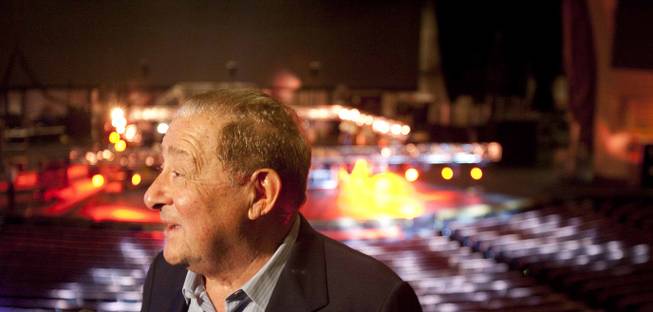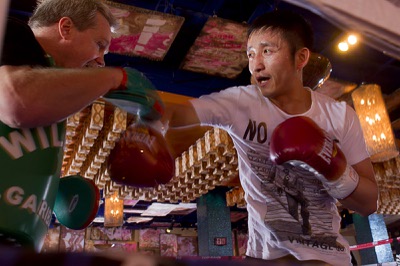
Earl Wilson / The New York Times
Fight promoter Bob Arum at Radio City Music Hall in New York, April 11, 2013.
Thursday, May 2, 2013 | 2 a.m.
Sun coverage
Inside New York’s Friars Club, at a table near the back, Bob Arum leaned forward. His eyes widened. His voice rose. Here came another vision, another sell — the next future of boxing, which followed the last next future of boxing, which followed the future of boxing before that — and Arum had seen it, experienced it and planned to capitalize on it.
Of course he had.
For much of his 81 years, for more than six decades, Arum has sold his sport, his fighters and himself. He has sold fights all over the world, from the Orange Bowl to Cowboys Stadium to a cow pasture in Gardnerville, Nev.; from Ohio to South Africa and so many points in between. He has worked through several boxing generations, from Muhammad Ali to Manny Pacquiao, as his sport shifted from a national treasure to a mainstream sports staple, and now from a niche sport in the United States to an increasingly global one.
But Arum had not seen it all. Not until last month. Not until he put on a bout in Macau, China’s gambling enclave, and looked over the numbers — so many of them staggering. Arum knew then that he had seen the next frontier, both for boxing and, to a greater extent, for sports. That is the vision he is selling. That is his next next.
“There’s a real story there,” Arum said excitedly, his hands moving as he talked. “Look into the future, and the truth is, the U.S. market is going to be secondary. The opportunities in the Asian market far exceed what you can do here.”
Arum insisted that he had seen the future of boxing and that it was in China and Singapore, and would perhaps spread elsewhere in Asia, such as the Philippines. That April 6 bout in China, the country that once banned boxing because it was too Western and too violent, featured a decorated Olympian from China in his professional debut, boosted gambling revenue at and drew high rollers to the Venetian Macau hotel and casino, and came with a favorable tax rate.
For all its success — the casino said it sold out the fight and estimated that 200 million to 300 million people watched on television — that event was in part a test run. Arum said Pacquiao would “definitely” stage his next bout, his first since Juan Manuel Marquez knocked him out in December, in either Singapore or Macau. Arum hoped to sell the fight for $3 to $5 on pay-per-view in China and at the usual rate (about $60) in the United States.
“Follow the money,” Arum said.

Chinese light flyweight boxer Zou Shiming (R) works on his timing with trainer Freddie Roach during a workout in a training facility at the Palazzo in Las Vegas, Nevada February 8, 2013. Zou, a two-time Olympic gold medalist and three-time world amateur champion, will make his professional debut April 6 at the Venetian Macao Resort in Macau.
He laughed. But he was serious.
Before Pacquiao became a global superstar, Arum envisioned showcasing him in Asia. He targeted Macau in particular. Then the Ultimate Fighting Championship held a mixed martial arts event there in 2012. It went well, and Arum had his aha moment. This year, he heard from the agent for Zou Shiming, the Chinese boxer with two Olympic gold medals. There it was, the final piece.
Like most everyone in sports, including power brokers for professional leagues in the United States, Arum wanted into China, with its population of more than 1.3 billion and heightened interest in Western culture, sports included. Kobe Bryant ran a basketball clinic in Macau. Rory McIlroy stopped there during a seven-day, seven-city golf tour. The Venetian sponsored a golf tournament on the Asian Tour.
Arum traveled to sign Shiming with Edward Tracy, chief executive of Sands China, which includes the Venetian in Macau. Tracy once managed the Trump Organization, which featured fights in Atlantic City, N.J. He agreed to do one bout in Macau, the one in April.
The logistics fell to Brad Jacobs, the event producer for Arum’s Top Rank Boxing. Jacobs traveled to China in February, and for two days he met with vendors, casino officials and production types. He learned it would be too expensive to deploy the television trucks normally used for an international production; so Top Rank flew in crates, ferried equipment from Hong Kong and created the equivalent of a production truck inside the arena at the Venetian.
Rather than start setting up on the Thursday or Friday before a Saturday night bout, they started the prior Monday. Top Rank sent roughly 20 people from its production team, then hired another 70 or so to aid in lighting, sound and production. Producers learned certain sayings in Chinese to guide the cameramen — pan left, zoom in.
Arum wanted to recreate the authentic experience of Las Vegas for a prime-time fight. He flew over broadcaster Larry Merchant, former heavyweight champion George Foreman and ring announcer Michael Buffer. Top Rank used a similar sound system, similar lighting, even brought a disc jockey from Las Vegas. Jacobs estimated the costs at double what it would have cost to produce the same event in the United States.
“I don’t think the crowd knew what to expect at first,” Jacobs said. “When we got to the third fight, the guy would get cracked on the chin, and they would react like we were in Las Vegas or New York or anywhere else. They were really into it.”
Tracy said the casino witnessed a 35 to 40 percent increase in overall gross gaming revenue on the weekend of the fight. This is gaming revenue, it should be noted, that dwarfs the take in Las Vegas (six times as much by some estimates, four or eight by others). Combine that with the ticket sales, Shiming’s popularity, the history of combat sports in Asia and the potential size of the TV audience (the Venetian, Tracy said, helped to underwrite “The Voice” in China, which nearly half a billion people watched) to understand the business model Arum sees. This is the same model some of the casinos followed.
Before he left in April, Arum and Tracy agreed to put on another card in Macau, in late July or early August, perhaps followed by Pacquiao in the fall. Arum said he could see Pacquiao signing a contract with the Venetian for three to five years at $5 million annually.
“There’s no question boxing has always followed the money,” Tracy said. “Right now, the money trail leads right to Macau.”

Join the Discussion:
Check this out for a full explanation of our conversion to the LiveFyre commenting system and instructions on how to sign up for an account.
Full comments policy